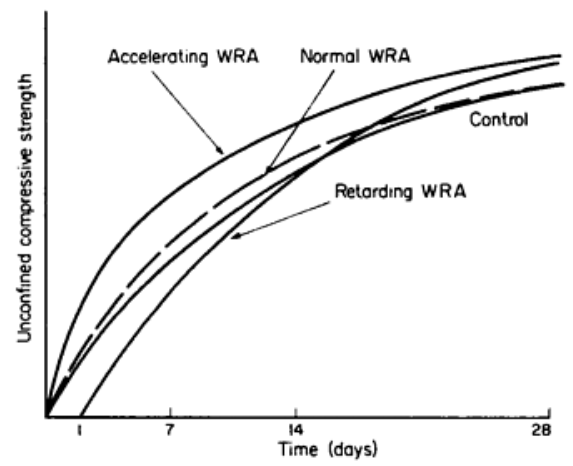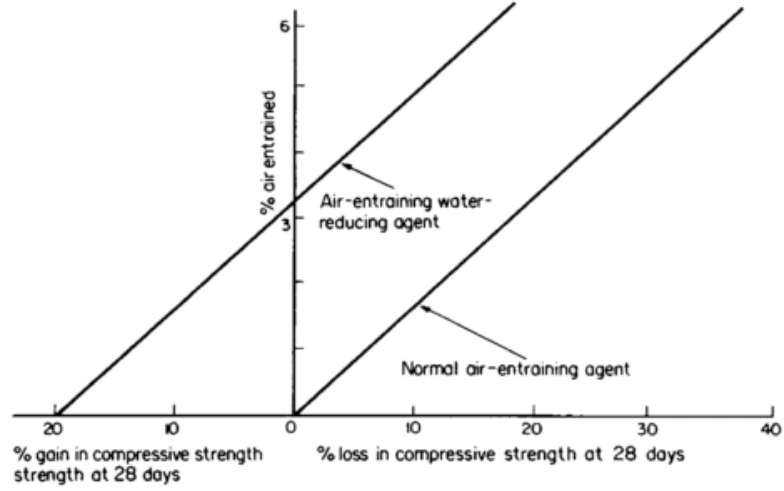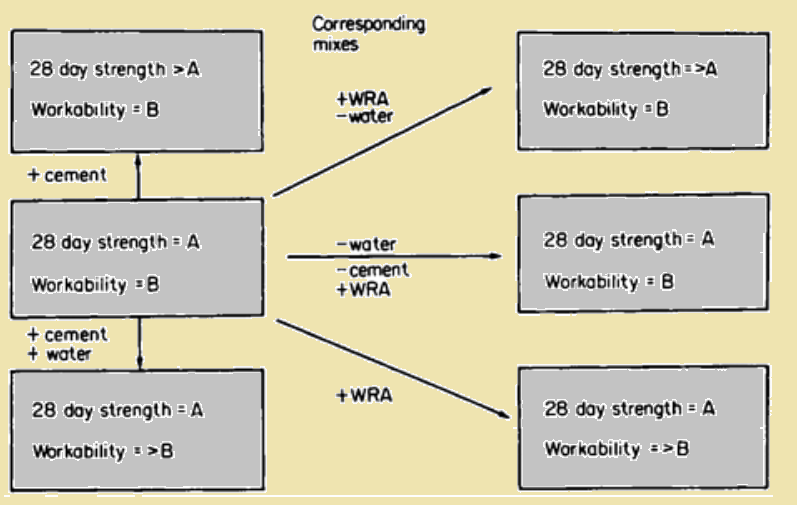Functions of Concrete Water-reducing Admixtures
What are Water-reducing Admixtures?
The water-reducing admixtures (also called water reducers, plasticizers, and superplasticizers in some cases) are the group of products which possess as their primary function the ability to produce concrete of a given workability, as measured by slump or compacting factor, at a lower water–cement ratio (w/c) than that of a control concrete containing no admixture.
Brief History on Water-reducing Admixtures
The initial use of water-reducing admixtures dates back to 1932 where the earliest known published reference to the use of small amounts of organic materials to increase the fluidity of cement containing compositions. This research claimed that polymerized naphthalene formaldehyde sulfonate salts were useful in this role.
This was followed by a number of revelations about the usage of lignosulfonates and better compositions between the middle of the 1930s and the beginning of the 1940s. Until the development of the hydroxycarboxylic acid salts in the 1950s, the lignosulfonates served as the foundation for nearly all of the water-reducing admixtures that were then available. These salts have since grown to hold a sizeable but still small place in this product category.
In North America, materials like glucose and hydroxylated polymers produced by the partial hydrolysis of polysaccharides are frequently employed. The polymers typically comprise glycoside units between 3 and 25 and have low molecular weights.
In addition, other chemical and admixture types have been included into the water-reducing admixtures formulations to produce five types within this category.
How can we use Water-reducers?
The typical water-reducing admixtures provide a decrease in the water-cement ratio at a specific workability without substantially altering the concrete’s setting properties.
In practical use, there are three methods to make use of this effect:
- By combining the addition of the admixture with a decrease in the water-to-cement ratio, it is possible to create concrete that is equally workable to the control concrete and has unconfined compressive strengths that are higher at all ages.
- Without making any further modifications to the mix proportions, the water-reducing admixture can be introduced directly to a concrete as part of the gauging water to produce a concrete with equal strength development characteristics but with improved workability than the control concrete.
- A concrete with similar workability and strength development characteristics can be obtained at lower cement contents than a control concrete without adversely affecting the durability or engineering properties of the concrete.
In all three ways of use that are mentioned above, the water-reducing admixture can be considered as a saver for the quantity of cement, as shown in Figure 1.
As a result, corresponding mixes are concrete mixtures that have the same characteristics for workability and 28-day strength. However, the mix that contains the water-reducer will have less cement than the other mix.
Of course, in fact, the parameters of workability and strength are determined by the needs of the specific situation; for example, areas congested with steel reinforcement will need a high workability, whereas extruded prestressed lintels require a very low workability.
For both situations, the load-bearing properties of the application will determine the strength needs. Therefore, the outcomes of similar mixes should be examined when comparing any admixture-containing concrete property, whether the investigation relates to strength, durability parameters, or statistical concerns like standard deviation.
It is more challenging to get greater strengths and workability by further increasing the cement content, despite the fact that the graphical comparison presented in Figure 1 and mentioned above is accurate for low and average cement concentrations up to around 350 kg/m3. The hydroxycarboxylic acid water lowering admixtures are especially helpful in this situation because they allow for significant gains in strength to be achieved without the expense and unfavourable consequences of adding a lot of cement.
Other Functions of Water-reducers
The other types of the water-reducing admixture group possess some other function which could not be obtained by mix design considerations.
Accelerating water-reducing admixtures
The accelerating water-reducing admixtures have the same water-reducing capability as the ‘normal’ category but in addition, they possess an accelerating feature. This accelerating feature give higher strengths during the earlier hydration period and faster setting times which allow finishing operations to be carried out in a timely manner, particularly at lower temperatures.
High proportions of accelerators (chloride or non-chloride), often a non-ionic surfactant, and water-reducing ingredients with minimal set-retarding effects, such as low-sugar processed lignosulfonates or blends of lignosulfonates with superplasticizers, are used in the formulation of this type of product. The mid-range water reducing admixture can be employed at larger doses, increasing workability or water reduction without unacceptably lengthening set times.
Retarding water-reducing admixtures
Retarding water-reducing admixtures, which frequently have comparable chemical compositions and perform similarly to “regular” materials when employed at greater dosage levels, prolong the time that the concrete remains in the plastic state. As a result, there is more time available for handling, placing, and finishing. In reality, the great majority (about 95 percent) of substances referred to as “retarders” are really retarding water-reducing admixtures, despite the fact that a small number of substances exist that solely have a retarding impact on concrete and little to no water-reducing potential.
The way in which the four types of water-reducing admixtures discussed so far affect the strength gain characteristics of concrete containing them is shown in Figure 2. The four concrete mixes have been designed to have approximately the same 28-day compressive strength, i.e. the admixture-containing mixes would contain approximately 10% less cement than the control mixes.

Air-entraining water-reducing agents
The air-entraining water-reducing agents possess the ability to entrain microscopic air bubbles into the cement paste whilst allowing a reduction in the water–cement ratio greater than that which would be obtained by the air entrainment itself. They are available in the normal and retarding form and also fall into two types depending on the level of air entrainment; the first type entrains only about 1–2% additional air and is normally used to increase the internal surface of the concrete to redress any deficiencies in fine aggregate gradings. The second type results in concrete containing 3–6% air and is used to enhance the durability of the concrete to freeze–thaw environments.
Figure 3 illustrates the key benefit of using this kind of material over a straight air-entraining agent: limiting the detrimental impact of air entrainment on compressive strength. As a result, when an air-entraining water-reducing additive is applied, up to 3 percent air may be entrained in a conventional concrete mix without changing the mix design or lowering the compressive strength.

Read Also:

